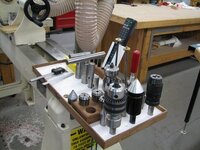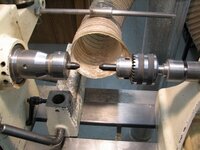Rangertrek
Member
Well, I converted to drilling my blanks on the lathe last weekend. I scr...up two blanks trying to drill a 10.5mm hole in Blackwood for a Jr. Retro Christian Fish pen. The blanks were in a pen drill vise and the bit 'wandered' off center anyway. The bench top drill press is a little sloppy and the combination caused a bad start to drilling the blank. The bushing barely even covered the hole.
My question is ... What tips do you have for drilling on the lathe?
I am using a drill chuck on the live center and a baracuda chuck to hold the blank on the business end. I can adjust the blank in and out of the chuck to expose more or the blank. Is there a better way, or preferred way to do this?
Thanks for any comments.
My question is ... What tips do you have for drilling on the lathe?
I am using a drill chuck on the live center and a baracuda chuck to hold the blank on the business end. I can adjust the blank in and out of the chuck to expose more or the blank. Is there a better way, or preferred way to do this?
Thanks for any comments.


